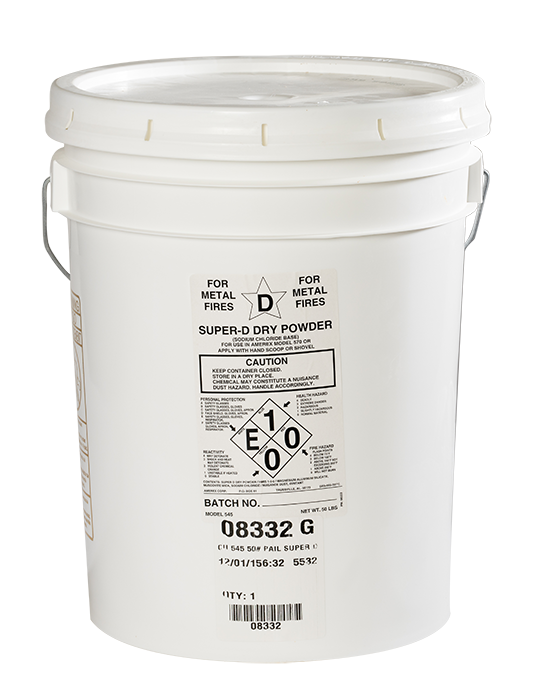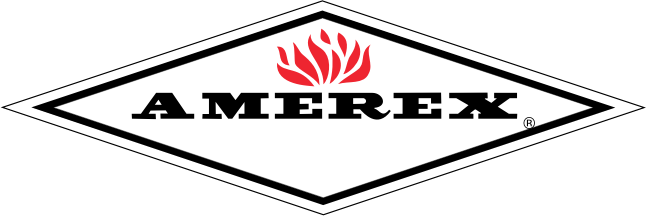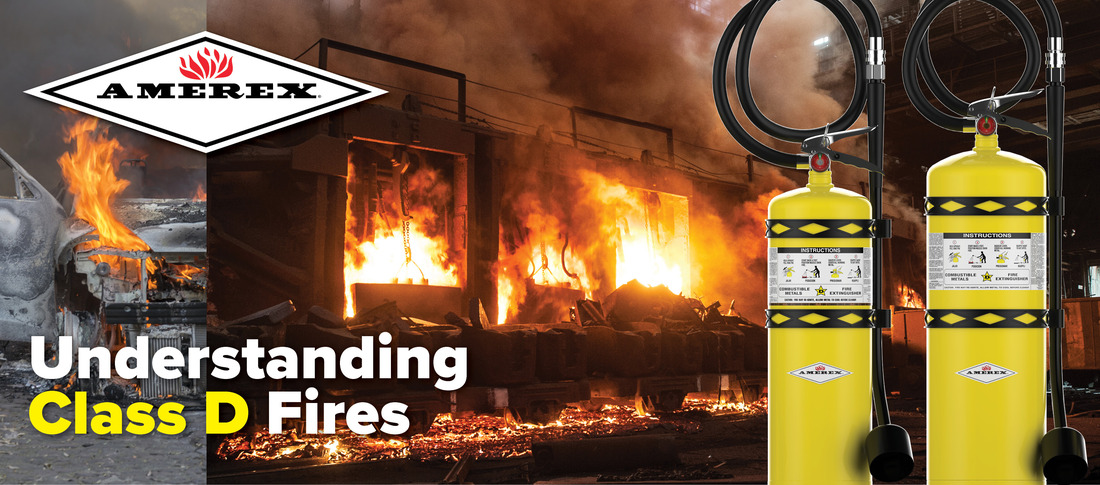Combustible metals have become increasingly common in our daily lives — notably aluminum, titanium and magnesium — and are widely used in the automotive and aerospace industries due to their impressive strength-to-weight ratios and high energy density.
Lithium’s energy density has revolutionized the battery industry, replacing internal combustion engines in numerous applications. Recognizing the unique properties of these metals is key to ensuring safe handling and fire prevention. However, these common applications are generally not the intended hazards Amerex Class D fire extinguishers are designed to knock down.

What are Class D fires?
Class D fires involve combustible metals or metallic alloy elements, such as magnesium, titanium, zirconium, sodium, potassium, lithium and zinc. These metals present extreme hazards not typically associated with Class A, B and C fires. When ignited, these elements can react violently with common firefighting agents (water, foam or halogens), causing explosions, toxic emissions and intense heat that can lead to additional hazards if not handled properly. The Class D extinguishing agent must suppress the fire without reacting physically or chemically with combustible materials.
Ideal uses for Amerex Class D extinguishers
Amerex Class D fire extinguishers and agents offer highly effective, targeted solutions specifically crafted to handle incipient stage fires involving combustible metal powders, flakes, shavings, chips or liquids.
According to NFPA 660, incipient stage fires are manageable with portable fire extinguishers and do not require special protective clothing or respiratory gear. Amerex Class D fire extinguishing agents and extinguishers are ideal for protecting mining, refining, processing, storage and manufacturing facilities where these raw materials are first processed to build products like batteries.
When NOT to use Class D fire extinguishers
In our industry, sometimes it’s valuable to clearly outline when our Class D extinguisher should not be used.
Automobile fires: While most automobiles contain some combustible metals, Amerex doesn’t recommend protecting every car with a Class D fire extinguisher. These metal parts are not in a combustible form. A fully involved vehicle fire may generate enough heat to melt these larger, finished chunks of metal and other Class A, B, C and D hazards. At that point, it is no longer an incipient stage fire.
Lithium-ion batteries: The lithium used in lithium-ion batteries typically exists in noncombustible compound forms, like lithium cobalt oxide, which are different from raw combustible metals. They do not present a combustible metal fire hazard. Only UL listed and Class C rated fire extinguishers are safe to use on battery fires, as Class D agents conduct electricity and could cause electrical shock hazards.
Download our safety information sheet: Lithium-Ion Battery Fires.
Amerex Class D extinguishing agents and extinguishers
Amerex offers specialized extinguishing agents tailored to efficiently handle diverse combustible metal hazards.

- Super D dry powder: A noncombustible formulation of sodium chloride blended with additives to improve its flowing and noncaking characteristics. It effectively smothers combustible metal fires with an even discharge from either the Amerex model B570 30-pound stored pressure hand portable or model 680 125-pound argon cylinder operated wheeled class D extinguisher — forming a protective crust that excludes air and dissipates heat.
- Copper dry powder: A nonabrasive, noncombustible pure copper powder that was developed by the U.S. Navy specifically for lithium and lithium alloy fires. The copper agent quickly cools fires and effectively adheres to vertical and three-dimensional surfaces. Its innovative use of argon as a pressurizing gas in the model B571 30-pound hand portable and model 681 250-pound Class D wheeled units ensures safety during firefighting operations.
- G-Plus dry powder (graphite): A black, nontoxic material consisting of finely graded, granular graphite (carbon) that’s normally applied to a metal fire using a spark-proof scoop or shovel. The granular powder serves as an excellent heat-conducting and smothering agent, quickly reducing fire temperatures below the ignition point and effectively sealing off air.
“Dry powder” is not the same as “dry chemical,” which is associated with extinguishing agents suitable for Class A, B and C fires. Some dry chemicals may create an explosive reaction when applied to combustible metal fires.
Essential safety training and compliance
To safely manage Class D fire hazards, regular training and adherence to OSHA regulations are critical.
- Regularly conduct practice drills and training for any possible users of the three types of dry powder extinguishing agents to ensure preparedness and confidence. We recommend providing training when an individual is initially assigned to a site and then on an annual basis.
- Consult safety data sheets for further guidance on safe and effective firefighting methods, breathing gear, and clothing protection tailored to specific combustible metals.
- Class D extinguishers should be located within 75 feet of combustible metal working areas.
Find the OSHA Requirements 29CFR 1910.157 (d) Selection and distribution. (6) and 29CFR1910.157 (g) Training and education. (1), as well as the description for NFPA 660 — Standard for Combustible Dusts and Particulate Solids — 3.3.64 Incipient-Stage Fire in our Class D Firefighting Tech Tip.
Confidence in your fire safety strategy
Amerex Class D fire extinguishers and agents empower industries to confidently handle combustible metal hazards. With specialized products designed specifically for these unique risks and comprehensive training support, Amerex helps ensure your people and property are prepared and protected. When you choose Amerex, you gain peace of mind knowing your fire safety strategy is sound.


